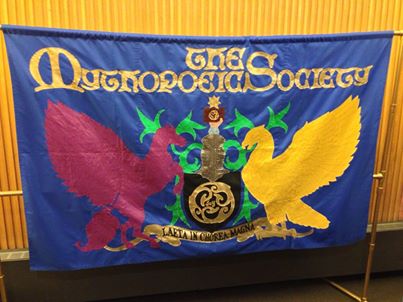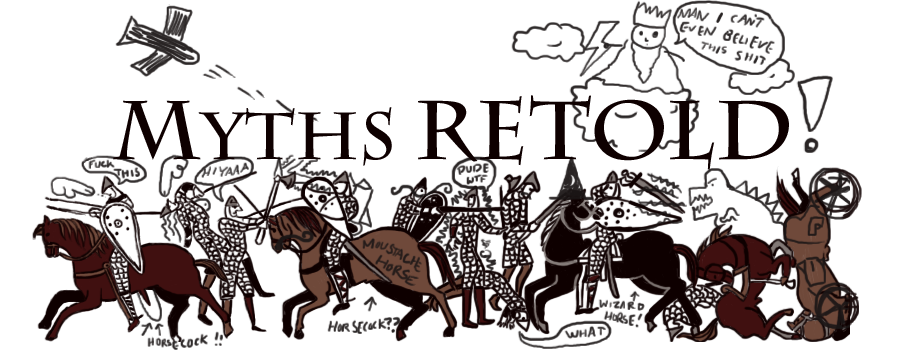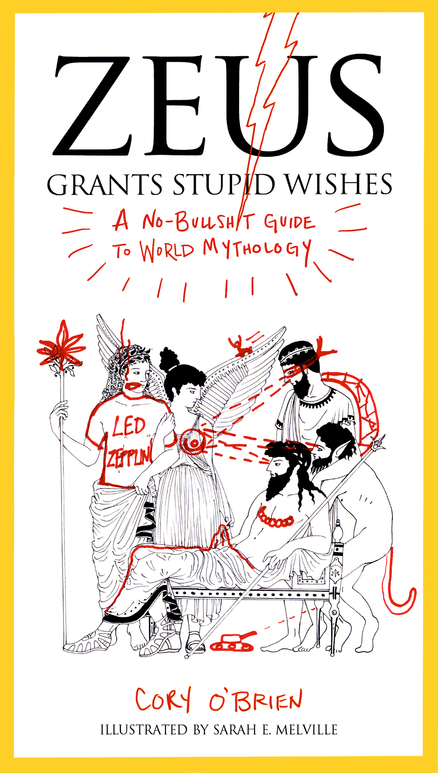The Jewel at the Heart of Everything

The surface of each jewel in the net of the god Indra reflects all the other jewels, whose surface reflects all the other jewels, and so on…. Change one jewel, and you change them all. Thus the net represents the interconnectedness of all things.
One of my favorite places is right in the middle of the intersection of science and myth. I think most people expect that as we zoom forward on one of these roads, traffic on the other must grind to a halt; otherwise, some horrible collision will litter the landscape with conceptual wreckage. After all, myth was our original way of explaining the world, way back when we didn’t know any better. (That solar eclipse? The god who carries the torch across the sky dropped it for a second.) Now that we have a scientific method of inquiry, we don’t need those myths that those superstitious crazy people of yesteryear took literally.
Right?
Here’s where I like to straddle that intersection and see what happens. For example, take a look at a really wonderful recent development in science, the “jewel” that may lie at the heart of quantum mechanics: the amplituhedron. (Let the word alone linger on the tongue for a minute; juicy, isn’t it?)
Quanta Magazine reports on the new framework for fundamental physics that the amplituhedron offers:
Physicists have discovered a jewel-like geometric object that dramatically simplifies calculations of particle interactions and challenges the notion that space and time are fundamental components of reality….
The revelation that particle interactions, the most basic events in nature, may be consequences of geometry significantly advances a decades-long effort to reformulate quantum field theory, the body of laws describing elementary particles and their interactions. Interactions that were previously calculated with mathematical formulas thousands of terms long can now be described by computing the volume of the corresponding jewel-like “amplituhedron,” which yields an equivalent one-term expression.
Okay, Let’s not sink too deeply into the physics of it (because I’ll get lost). Suffice to say that it seems this jewel-like geometric construct accounts for the behavior of matter and energy on the most fundamental level. What an elegant, beautiful idea, which makes my mind flash to another elegant idea; juxtapose the amplituhedron with one of the most gorgeous of mythic constructs, from Eastern religions: Indra’s net.
Far away in the heavenly abode of the great god Indra, there is a wonderful net which has been hung by some cunning artificer in such a manner that it stretches out infinitely in all directions. In accordance with the extravagant tastes of deities, the artificer has hung a single glittering jewel in each “eye” of the net, and since the net itself is infinite in dimension, the jewels are infinite in number. There hang the jewels, glittering “like” stars in the first magnitude, a wonderful sight to behold. If we now arbitrarily select one of these jewels for inspection and look closely at it, we will discover that in its polished surface there are reflected all the other jewels in the net, infinite in number. Not only that, but each of the jewels reflected in this one jewel is also reflecting all the other jewels, so that there is an infinite reflecting process occurring.
That description, from Francis Harold Cook and his book Hua-Yen Buddhism: The Jewel Net of Indra (via Wikipedia) evokes as much wonder in its way as the amplituhedron. And while the confluence of ideas isn’t perfect—one jewel predicts all particle interactions, the other jewels reflect all others ad infinitum—they both give us insight into the fundamental nature of existence, how all things on a deep level are connected.
Instead of smashing into each other and leaving wreckage everywhere, these two modes of thinking, while never merging, seem to have ended up on parallel tracks; instead of gridlock, they’ve managed to clear the road for each other by staying out of each other’s way. As long as you’re clear about which lane you’re driving in at any given moment, there’s no reason great progress can’t be made on both roads.
And that’s the trick, isn’t it? One has to be able to hold two ideas in one’s head at the same time, the empirical reality and the metaphorical Truth–like people in our predecessor cultures probably did. C’mon; do you really think they were any less savvy that their stories weren’t nuts-and-bolts descriptions of how the world does what it does? Do you truly believe that they were more prone to the trap of taking one’s metaphors literally than today’s Christian and Muslim fundamentalists of the lunatic fringe?
That ball of fire in the sky isn’t a god carrying a torch, but the tale still told a people who they were, that there was duty to perform, that even gods stumble and drop their responsibilities every once in a while, but that you pick it back up and get going again…so yeah, in ways that matter deeply to us, that ball of fire is a god carrying a torch. These Truths are what myth is about, and it’s why religion (read: myth) continues in various forms even as science takes its rightful place in our brains and our culture. Myth isn’t diminished by science; properly understood, each in their proper role, they can almost propel each other forward, amplituhedron to Indra’s net.
So get in the fast lanes where myth and science meet, and enjoy the ride.
The Story of the Smith
Creation myths are the bread and butter of mythology; everybody’s got one (except the Buddhists). From “God said, Let there be light” to the Australian Aboriginal Dreaming, creation myths not only explain where the world came from but establish humanity’s place in it, and they can give insight into a culture’s philosophical underpinnings. Even the lack of a creation myth is telling: Buddhism focuses on the human condition as it is, finding where we came from irrelevant; we are here now, and that’s all that matters.
(One of my favorites is the origin of human beings according to the Potawatomi tribe of Wisconsin. Their creator god made clay figures and baked the first too little, resulting in the half-baked white people; the second too much, yielding the overbaked black people; and got it just right the third time, so that–voila!–the red people of Native American tribes came forth. At least, that’s the tale as related by Dorothy Moulding Brown’s “Indian Fireside Tales” from 1947. Whether the myth predates contact with those of European and African ancestry is a fascinating question…)
So what can new creation myths tell us?
I leave that for you to discern. Instead I offer this lovely find: “The Story of the Smith,” by Morag Spinner/Katje van Loon. She’s a pagan, and the modern neopagan movement, in its ongoing attempts to create new religion, is fertile ground for new myths and gorgeous images:
She saw the candles flicker, farther away, little pinpoints of light in the inky blackness. She was within each flame as she sat at the Anvil, hammering on the rod. Sparks flew off and became planets, and flew to spin around the candle flames, tiny stars in the night. Her stars.
Soon all the planets would be done, and the sparks would become souls instead, to populate those planets. She would stretch, past infinity, and the Deep One with her. His deep waters would hold her bright flames as they became as close to one as possible.
Go read the whole thing (it’s a nice, concise read) at Morag’s site, but come back here to tell me what you think.
–CFC
And Thor? He Swung a F*cking Awesome Tool
In the search for myths for today, one invariably comes across the myths of yesterday—but rarely told like this. Myths Retold (bettermyths.com) could be faulted for its sexism (not to mention an occasional whiff of homopanic)…but then that’s more often a flaw of the ancient myths themselves, a defect of their times. What sets these (surprisingly faithful) retellings by crazy grad student Cory O’Brien apart is the refreshing irreverence, an appreciation for the flesh of these tales while clothing them in an exuberant frat boy’s flashy outerwear.
In other words, they’re funny as hell.
(Foul-mouthed, too.)
I especially appreciate the breadth of O’Brien’s interests, moving beyond the usual Greco-Roman and northern European pantheons to range from the Old Testament to oft-neglected African and Eastern myths. And he throws in modern literary inventions to boot; he’s dismantling Tolkein’s Silmarillion as I write this.
Think of Myths Retold as Classics Illustrated with an R rating…the Cliff Notes of Mythos…Deities for Dummies…
And he’s a got a book of them available, too:
Myth That’s Only Skin Deep
I’ve never read Rick Riordan’s Percy Jackson series of novels ; seeing as they’re aimed at a young adult audience, I’m a little outside their demographic (just a little). But I saw the first movie adaptation, PERCY JACKSON AND THE OLYMPIANS: THE LIGHTNING THIEF, and found it charming enough to warrant a look at its sequel.
Ugh.
But the artistic merits of the film version of PERCY JACKSON: SEA OF MONSTERS–or lack thereof–isn’t the point here (it is very much the point next door where Your Sacrificial Moviegoer holds sway; you can read about it over there). The real question is: In the search for myth in our modern world, can it be found in the guise of this young hero and his celluloid adventures?
Unfortunately, no. What we have here is the pedestrian with a veneer of myth.
A little context: The premise of the Percy Jackson series is that the Greek gods are real and still among us, siring demigods with the same frequency that busy street corners spawn Starbucks. These teen demigods gather at Camp Half-blood, a sort of Adirondack summer camp for the semi-divine, and wackiness ensues. If the setup sounds familiar—unloved outcast youth discovers he’s really something special and goes to that special place where special people go—that’s because it is.
And there’s not much more to say about it than that: mortals for muggles, Half-blood for Hogwarts, demigod whiz kids for wizards. This could be any kiddie adventure; it just happens that the special abilities are dressed up in Olympian drag.
That isn’t a bad thing, if it lures young folks into exploring the classical myths that are appropriated and exploited for this adventure series. But as a candidate for myth itself, Percy Jackson doesn’t even come close. It doesn’t grapple with the Big Truths of human existence or use metaphor to locate humanity’s place in the universe. This series was never intended for that; it explores teen angst and absentee daddy issues, feelings of inadequacy and the bonds of friendship. While the last of these could potentially rise to the level of myth under some circumstances (think Gilgamesh and Enkidu), an endless bunch of snarky spats over who the cool kids are isn’t one of them.
A good friend of mine reports that his 11-year-old nephew, who loves the books, was as let down by the SEA OF MONSTERS movie as I was. So maybe the books are more rewarding…and will hopefully serve as a gateway for young readers to the rich worlds of real myth.
Mythic Themes in PACIFIC RIM? Who’d a Thunk It?!
At first blush, it’s just another big-budget summer blockbuster (in this case, considering the damage inflicted wholesale on cities, literally a blockbuster): PACIFIC RIM pits giants made of steel against rampaging monsters of equivalent dimensions, purely for popcorn-eating fun. But that doesn’t mean that some deep-seated mythic tropes aren’t at work here.
The world’s mythologies are rife with demons and monsters, symbolic of chaotic, often primordial forces—dread beings preceding the gods, whom the gods defeat to bring order to the universe. Most famous in our Western culture are the Titans of Greek myth, overthrown by the Olympians and imprisoned in Tartarus. The jötnar (“giants,” more or less) occupy a similar place in Norse mythology to the Titans for the Greeks. In PACIFIC RIM, the Titans have come spilling out of Tartarus—or rather, the kaiju, as the giant monsters are called, have begun spilling out of an interdimensional rift on the Pacific Ocean floor. Wantonly destructive, they threaten to bring about the collapse of human civilization.
Enter the jaegers, giant suits of battle armor piloted by pairs of soldiers. Technically, these are high-tech tools–glorified tanks, if you will. But functionally, they’re gods: anthropomorphic, of great stature, and with superhuman strength and abilities. Like deities, each has a snappy moniker, and far from being mass-produced lookalikes as tools would be, each is unique in appearance and ability—again, like deities. In their embodiment of stereotypes (for example, the Russian-piloted jaeger has the clunky but durable appearance of aging Soviet-era tech), the jaegers echo the gods’ embodiment of archetypes and begin to take on glimmers of nascent personality (albeit of the most cartoonish sort). Most importantly, they act as gods, in that they battle the primordial monsters to try to maintain the civilized order of the world.
After all, why fight megamonsters with giant armorbots, as opposed to just blasting the hell out of them with more conventional weapons? The movie never really addresses that question. The obvious answer is that a movie where the monsters go toe-to-toe with giant ‘bots is infinitely cooler. But why is it cooler? What makes that so much more appealing to filmgoers? I’d argue that it strikes the deep-seated, mythic chord of gods struggling against the demons of chaos.
That chaos is not just external. In many Eastern mythologies, the demons are manifestations of the evil within: humankind’s worst attributes. This same externalization of internal flaws can be seen in PACIFIC RIM’s immediate antecedents, the Japanese and Korean monster movies of an earlier generation, led first and foremost by Godzilla (Gojira in the original Japanese). Godzilla is the product of nuclear devastation, so yes, he represents the chaotic environment; but the fact that the devastated environment that spawned him was the result of humanity’s failures makes him a demon of our worst attributes, too. Similarly, in PACIFIC RIM, the kaiju find Earth so attractive now because humanity’s global warming and pollution have converted our biosphere into one much more hospitable to them. Like Godzilla before them, they are demons of both a chaotic environment and our own inner flaws.
But perhaps the best reason that PACIFIC RIM invokes mythology so strongly is because of its scale. Giant humanoid beings battle giant monsters for the greatest of stakes—the fate of the world—and we dwarfed mortals and our precarious cities can only watch in awe. Innumerable movies feature noble characters, often with superhuman powers, battling monsters of darkness, yet they don’t all tap the mythic imagination so pointedly. I think that’s because myth is about going big—as I’ll discuss in an upcoming post.
None of this is explored in PACIFIC RIM in any meaningful way; this flick is just for kicks (again, literally). But it’s interesting to recognize these elements at work on the subconscious level. We shouldn’t be surprised at its mythic roots, however; the mind behind this mayhem is filmmaker Guillermo del Toro. He’s done this before, only better, when he brought the achingly beautiful PAN’S LABYRINTH to the screen, using myth to its best effect—to illuminate, inform, and transcend our (in that case painful) reality.
Mythcon 44: Final Report

Just in case you thought Mythcon was all scholarly egghead stuff, it wraps up with silly season:
- I learned at the banquet that at Mythcon they play with their food. More than that I cannot say; you have to experience it for yourself.
- Masquerade! Costumes of characters from your favorite works of fantasy parade on stage. Everybody wins, and the cleverly phrased awards are possibly more entertaining than the costumes themselves.
- Makeshift band Where Did Our Ringo sings, the Not-Ready-for-Mythcon Players perform Watership Downton Abbey, champions of the extreme sport known as golfimbul (don’t ask) are heralded by kazoo, piquant poetry is proffered,…
You get the picture.
After a weekend together, camaraderie reigns, epitomized in a round of song sung as a group, which apparently is how every Mythcon comes to a fitting end. Exploring the creation of myth can be lonely work; it’s not a field with widespread appreciation (yet; it is the job of this blog to start fixing that). Mythcon welcomes you warmly into a society of friends who recognize the majesty of mythmaking; reason enough to rate it a rousing success. –CFC
Mythcon 44: Day 3
By the third day, Mythcon takes its toll.
It’s not that I don’t want more of everything this gathering of scholars and enthusiasts of Tolkien and mythmaking has to offer; but my body is on the verge of collapse from lack of sleep. Getting up for the morning panels and staying up late for Bardic Circle was bound to catch up with me.
Somehow I managed to stay wide awake for today’s morning panels: two playful, very particular examinations of Tolkien from angles you’d never dream of, and a penetrating scholarly take on the mythic underpinnings of the fantasy novels of E.R. Eddison. The morning was capped by fantasy author Franny Billingsley‘s engaging and enormously informative “The Writer’s Craft: Creating the Fictional Dream,” a nuts-and-bolts primer on punching up one’s fiction writing. (Just one of several well-crafted turns of phrase she offered, this one off the cuff, regarding the hyperrefrigerated auditorium we inhabited: “They pass the air under Greenland before recirculating it in here.”)
After lunch, I had the distinct pleasure of listening to another fantasy author, Saladin Ahmed, read from his work. I’d been looking forward to his reading since I’d seen the schedule for the convention, since his Muslim/Arabic-themed fantasy world and perspective add a hue other than medieval European to the mix; lamentably, hot competition with another simultaneous presentation meant Ahmed’s reading drew poor attendance. Those of us who were there got the better deal, I suspect.
And then my body shut down. Roger Echo-Hawk‘s thesis that Tolkien drew not only from northern European mythology but also from the mythos of the Pawnee was intriguing, though I remain skeptical, since so many similar themes and tropes arise independently in the mythologies of farflung cultures that couldn’t have crosspollinated; some mythic images seem to pop up simply because we’re human. But I can’t really critique him properly, since most of what he said came to me only through the semiconscious haze of my nodding off.
That’s a clear sign if ever there was one. So I’m signing off for now, to catch a nap and be fresh for tonight’s festivities: the banquet, awards, evening entertainment (including a masquerade!), and of course, Bardic Circle.
Mythcon 44: Day 2
This is why you should go to Mythcon: because when you’re not expecting it, someone will give you an insight that will change your work, open a door, shake up your point of view.
For me that moment came at about 11:25 in the morning. Remember that professor of English from Nova Scotia I mentioned yesterday? Turns out that Prof. Anna Smol presented a talk today (I’m posting after midnight, so technically yesterday) on “Tolkien’s Painterly Style” that clearly delineated the techniques that set the master mythmaker’s prose a cut above the rest. When she contrasted a Tolkien passage with a descriptive passage randomly selected from another author, it was as if blinders had been lifted from my eyes. I could not only see what a fine tuning of my own writing could accomplish, but I’d been handed the tuning fork with which to go for perfect pitch, if I dared. A rare gift indeed!
Another gift arrived in the form of Verlyn Flieger’s focused analysis of tree spirits in The Lord of the Rings. I’ve wanted to meet her for a while now, and I was not disappointed; her approach to mythic work is as insightful as her CV suggested.
Which highlights another plus of Mythcon: Its small scale makes it an intimate gathering where you can’t help but have personal interaction with presenters and honored guests. These people know their stuff to a nearly subatomic level of detail (at tonight’s Bardic Circle, an ace linguist rattled off the Lord’s Prayer first in Old English and then in Middle English, so we could compare the evolution of the language!), which would be intimidating except for the fact that you’ve had ice cream with them earlier in the convention, and they’re all so unassuming and damn friendly.
Not every forum is going to be a match for your particular interest, and sometimes it can be tough to tell which presentations those will be. But there’s enough quality—and fun (Buffy the Vampire Slayer presentation, anyone? Or a performance by a wildly enthusiastic fiddler band?)—that you will stumble onto satisfaction despite yourself.
Your 11:25 AM epiphany awaits.
Mythcon 44: Day 1
Looking for folks exploring the creation of myth and fantasy? Try the Mythopoeic Society, which as I write this is holding its 44th annual gathering, Mythcon, a fertile mix of scholarship and fun. Intensely curious as to what such a gathering might be like, I decided to travel to the convention and report back…
First of all, the participants are friendly; I’d been made welcome by a professor of English from Nova Scotia before I’d even reached the graceful campus of Michigan State University in East Lansing, where Mythcon is unfolding over this weekend. Though the attendees are overwhelmingly white, I haven’t sensed any exclusionary impulses. People with disabilities mingle easily with everyone else, and a variety of ages are here, though understandably in a crowd littered with so many established academics, it skews a bit older.
The Society focuses on the works of Lord of the Rings author J.R.R. Tolkien—the master of all mythmakers—and his contemporaries, but not to the detriment of other mythic efforts. For example, my favorite presentation of this shortened first day came from Vicki Ronn of Friends University; her intriguing “Witches in the Wild: Old Women on the Boundaries” illuminated the economic and misogynistic origins of the ‘wicked old witch in the woods’ archetype and examined how it persists and has evolved in fantastical literature to this day.
But the best part of Mythcon came last. I’d read that a “Bardic Circle” took place in the evenings, and hoped for an engaging exchange of storytelling over the conceptual campfire; it turned into so much more. An unassuming hotel hospitality suite came alive as one by one folks fearlessly offered whatever moved them: some sang a song unexpectedly lovely from untrained voices; others read from their own work, while still others recited a favorite famous poem. With a ferocious honesty and openness, everyone in that room brought it, whatever “it” meant to them. I entered that room exhausted from a long day of travel and thought-provoking discussions; I left inspired.
The First Myth I Ever Wrote–and Why It Fails (Part 2 of 2)

In the Australian outback, the natural markings on Uluru are the aboriginal people’s myths literally written in stone.
Last time, I offered “Up in the Air,” a very short myth recovered from the mists of time (in other words, the 4th grade). I then promptly branded it as unsuitable for status as a true myth.
So what the hell is wrong with it?
After all, it’s clever enough (for a 4th grader, anyway). I followed the teacher’s instructions to the letter; I’m sure I got an “A”. Just as she told me, just as millions of schoolchildren still do per the instructions in myth-writing lesson plans, I came up with a story that explains a natural phenomenon in a creative way.
And therein lies the problem, because that’s not what myth is all about.
Sure, myths are often linked to nature; perhaps the most literal case can be found in the heart of Australia, where each natural crack and formation on the surface of its famed giant monolith, Uluru (Ayer’s Rock), is connected to a myth of the aboriginal people of the area. Their stories are embedded in the rock. But what matters is not the mechanical end product—how the rock got this crack in this place—but what the stories say about a people, about the world around them, and how the tale connects the two.
“Up in the Air” fails that test. It’s mostly mechanistic, giving a reason for the rain and roar and flash of a thunderstorm, but saying little else. What few tidbits one can glean from the story are a 4th grader’s rather unevolved, simplistic view of gender roles:
- Women do nothing but daub themselves with perfume and cry a lot. They aren’t active participants in shaping their own fate.
- Overbearing paternalism is the word of the day.
- Stalking is cool! And fighting over girls is even better.
OK, I’m overstating the case, but I don’t find a lot of insight into the human condition or the way of the world here. (To be fair, if I had that kind of insight as a 4th grader, by now I’d be The Most High Holiness of Enlightened Consciousness, or something else rather grand.) This myth may be clever, but it’s not True.
However, I’m warming to the idea of a subversive retelling: For all we know, Princess Rayne is very much an active participant in her destiny, cleverly daubing herself with telltale perfume to give away her location to her desired lover…. (But which of the two princes does she desire? Or, more provocatively, is she trying to lure someone else entirely?) It doesn’t deepen this myth tremendously, but it’s fun to think about. –CFC



